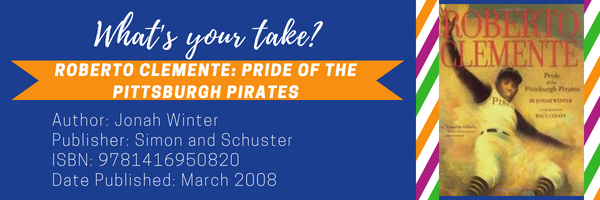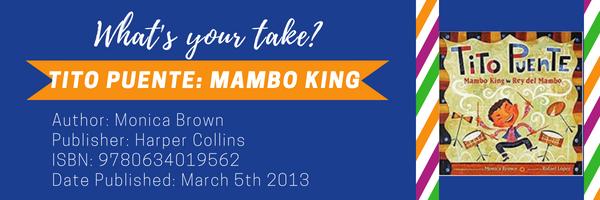This July, René Picó and Charlene Klassen Endrizzi delve into the cultural complexities of the Puerto Rican experience. The books are selected to allow readers to uncover more layers of idiosyncrasies. We want to reveal how Puerto Rico “is a human archipelago… self-assertive, puzzling and contradictory.”

Our Week 2 conversation focuses on the contributions of two acclaimed Puerto Ricans. The first, Tito Puente, portrays de aqui (from here) since he was born in Spanish Harlem. The other one, Roberto Clemente, de alla (from there) was born on the island; nonetheless both are Puerto Ricans. On several levels these well-known Latin Americans’ lives reflect the inhospitable circumstances facing many immigrants today. Their stories of struggle and success parallel our new generation’s aspirations.
RENÉ: Let’s begin with Jonah Winter’s thought-provoking text. Unlike our newcomer Arturo Schomburg, whom we discussed last week, a leader who overcame racial hostility, Roberto Clemente’s sports career in northeastern United States was plagued with injustice. Winter chronicles the depth of Roberto’s accomplishments along with some hardships he endured.
As an 8-year-old boy in Puerto Rico, I remember enjoying Clemente’s 3,000th baseball hit as I laid on the floor of my parent’s living room. The big glowing number on the screen was so memorable. I never realized that his Major League baseball career was mined with such hardships–open discrimination, slurs from the crowds, blunt curses about the color of his skin and the mockery of his accent. In my eyes, Roberto was someone who made it big time. I did not know that for many Yinzers, he was always seen as that Black-Puerto Rican.
CHARLENE: This historical picturebook portrays the passion and pride this Puerto Rican brought to baseball. Yet, it ironically also reveals the City of Champions’ struggle to accept a sports figure who did not fit into their world view.
RENÉ: Jonah Winter highlights Clemente’s marvelous sports feats but also tells us how those efforts were ignored by many fans and the media. I remember several other black players on the 1970s Pittsburgh Pirates’ team. While reading, I wanted to learn more about the struggles other teammates encountered. I also wondered–what were the major differences between the Black guy from Puerto Rico and the Black guys from the mainland? What triggered such high levels of discrimination?
CHARLENE: These questions could easily launch an exploration of the Negros Leagues (1880s-1940s) and notable Pittsburgh teams like the Homestead Grays.
Even though I live near Pittsburgh, I admit that my son and I explored Jackie Robinson’s career more than Clemente’s. This was because Jackie’s entrance into the major leagues occurs on my son’s birthday, April 15. Unfortunately Jackie’s arrival, followed by multiple baseball pioneers like Larry Doby (Just as Good, 2012) and Roy Campanella (Campy, 2007), did little to ease Roberto’s entrance into our nation’s favorite pastime. They each faced fans who openly displayed their disdain for difference.
No wonder Roberto continued to return home to Puerto Rico where he was welcomed back by adoring fans! Prior to a fatal plane crash that cut short his life at 38, he evolved into a beloved humanitarian. He primarily focused on offering Puerto Rican children baseball clinics and helping Latin Americans in need.

RENÉ: Shifting to our second book, my memories of Tito Puente come from Puerto Rican television variety shows. Tito’s flamboyant tropical, ruffled shirts were an eye-catching experience in addition to his stunning dance moves as he stood behind his timbales. In contrast to Clemente’s story, Tito Puente: Mambo King offers a cheerful narrative. Monica Brown does not delve into any discrimination Tito might have faced outside of Spanish Harlem.
CHARLENE: My eyes quickly focused on the large print Rafael López used to punctuate the timbales, congas and bongos sounds. Re-creating these sound effects (onomatopoeia) can help younger readers begin to understand the power of Tito’s music. I appreciate Rafael’s artistic efforts to evoke movement as well. Tito was a lively entertainer, depicted by Rafael’s clever use of four instead of two arms beating energetically on the timbales.
I also appreciate how Monica Brown decided to share the story in both Spanish and English. This choice can lead into conversations regarding Tito’s use of Spanish, his first language, to share his music.
RENÉ: We have two great stories with completely different characters. What factors make these two stories so different? Is it because one is from aqui (from here) and the other is from alla (from there)? Is the color of their skin a defining factor? Did their names influence their interactions with others, Ernest Anthony Puente v. Roberto Clemente? Does an American accent provide an advantage?
CHARLENE: These complex questions can hopefully lead to readers’ own questions. Puerto Ricans from here and there can also launch conversations about our nation’s immigrant struggles today.
We close Week 2 with a timely thought from Roberto Clemente. “I don’t believe in color; I believe in people. I always respect everyone, and thanks to God, my mother and father taught me never to hate, never to dislike someone because of their color. I didn’t even know about [racism] when I got [to the United States].” (Clemente, 1972)
Title: Tito Puente: Mambo King
Author: Monica Brown, illustrated by Rafael López
Publisher: Harper Collins
ISBN: 9780634019562
Date Published: March 5 2013
Title: Roberto Clemente: Pride of the Pittsburgh Pirates
Author: Jonah Winter, illustrated by Raúl Colón
Publisher: Simon and Schuster
ISBN: 9781416950820
Date Published: March 2008
This is the second installment of July’s My Take/Your Take. Take a look at our first post about Arturo Schomberg, and make sure to check back next week to follow the conversation.
- Themes: Charlene Klassen Endrizzi, Jonah Winter, Rafael Lopez, Raul Colon, René Picó, Roberto Clemente, Tito Puente
- Descriptors: Books & Resources, My Take/Your Take

It’s funny — when you put children in a room, all they seem to see is another little human being in front of them, but they don’t see physical features that “don’t fit” their idea of what is right or wrong — they just notice unique qualities. I remember when my own blonde hair/blue eyed daughter came home from preschool one day wishing for brown skin, brown eyes and curly hair. Thinking that she was speaking about LaQuisha, it wasn’t until she asked for a red dot on her forehead that I realized that she was speaking about her new little friend, Suma — and I quickly took my lipstick, gave her her own special pink dot so she “could be pretty, too.” For kids who do not experience a myriad of different cultures in their life, literature that helps kids connect with wonderful differences can help them celebrate those unique qualities. Perhaps even better, parent inclusion could really make a big impact; what if children were to select a favorite story to share during a literature fair? Similar to a science fair, parents/guardians/community members might travel around a gymnasium where children stand at their respective stations to present what they learned. A 3rd grade “Roberto Clemente” with his wooden bat might talk about the humanitarian projects he learned about in the story; a kiddo dressed in ruffle-clad sleeves might turn on Latin dance music to show off a few Mambo moves to share the story of Tito Puente. As many teachers already know, children have a lot to teach adults, and those lessons can reach well beyond a simple story.
This Roberto Clemente text is one of the favorite books in my 3rd grade classroom library. Athletes are in a unique position of power when it comes to influencing youth and setting a positive example for all citizens. It is incredibly helpful to have texts at our students’ fingertips about positive role models from around the globe, especially role models who have overcome adversity and injustice. Without such texts, many students may have a very limited view of overcoming obstacles and finding ways to help the greater good.
Jen and Lyn, You both quietly value the risks teachers take, even in conservative areas like ours, to share books that offer another lens on life. You understand the responsibility teachers have to help their students look beyond their own lives, and explore their status as global citizens through children’s books. Creating a Literature Fair for families is a thought-provoking avenue to help parents ponder diverse role models who have faced adversity and overcome hardships. The power of making children our leaders and teachers during a family night is another way to promote critical thinking.